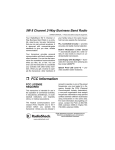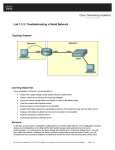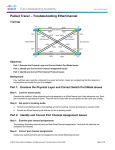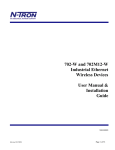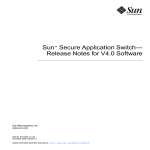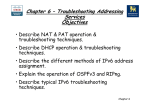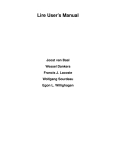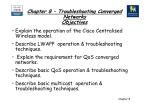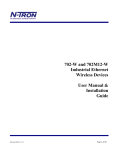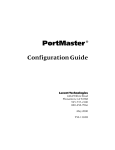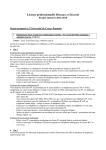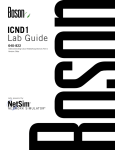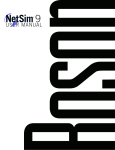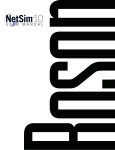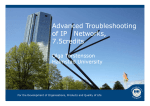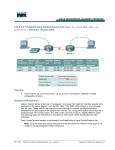Download Troubleshooting of Switching, HSRP and Addressing Services
Transcript
Troubleshooting of
Switching, HSRP and
Addressing Services
CCNP TSHOOT: Maintaining and Troubleshooting IP Networks
TSHOOT v6 Chapter 4
© 2007 – 2010, Cisco Systems, Inc. All rights reserved.
Cisco Public
1
Lecture 1: Objectives
LAN switch operation
Troubleshooting of:
• VLANs
• STP and Etherchannel
• Inter-VLAN routing
• HSRP, VRRP, and GLBP
• NAT/PAT
• DHCP
Chapter 4
© 2007 – 2010, Cisco Systems, Inc. All rights reserved.
Cisco Public
2
Review
Before you start to troubleshoot, make sure you know the
operation of the following protocols and functions:
• LAN switch operation
• VLANs
• Spanning-Tree Protocol (STP)
• Etherchannel
• Inter-VLAN routing
• First Hop Redundancy Protocols (HSRP, VRRP and GLBP)
• Addressing Services (NAT/PAT and DHCP)
Chapter 4
© 2007 – 2010, Cisco Systems, Inc. All rights reserved.
Cisco Public
3
LAN Switch Operation
Issues that could cause the communication to fail:
•
•
•
•
•
•
•
•
•
•
•
•
•
•
Physical problems
Bad, missing, or miswired cables
Bad ports
Power failure
Device problems
Software bugs
Performance problems
Misconfiguration
Missing or wrong VLANs
Misconfigured VTP settings
Wrong VLAN setting on access ports
Missing or misconfigured trunks
Native VLAN mismatch
VLANs not allowed on trunk
Chapter 4
© 2007 – 2010, Cisco Systems, Inc. All rights reserved.
Cisco Public
4
Verifying Layer 2 Forwarding
Common findings when following the path of the frames through the
switches:
Frames are not received on the correct VLAN: This could point to
VLAN or trunk misconfiguration as the cause of the problem.
Frames are received on a different port than you expected: This
could point to a physical problem, spanning tree issues, a native VLAN
mismatch or duplicate MAC addresses.
The MAC address is not registered in the MAC address table: This
tells you that the problem is most likely upstream from this switch.
Investigate between the last point where you know that frames were
received and this switch.
Chapter 4
© 2007 – 2010, Cisco Systems, Inc. All rights reserved.
Cisco Public
5
Verifying Layer 2 Forwarding – Cont.
Useful Layer 2 diagnostic commands:
show mac-address-table: Shows learned MAC addresses and
corresponding port and VLAN associations.
show vlan: Verifies VLAN existence and port-to-VLAN associations.
show interfaces trunk: Displays all interfaces configured as trunks,
VLANs allowed and what the native VLAN is.
show interfaces switchport: Provides a summary of all VLAN
related information for interfaces.
show platform forward interface: Used to determine how the
hardware would forward a frame.
traceroute mac: Provides a list of switch hops (layer 2 path) that a frame
from a specified source MAC address to a destination MAC address
passes through. CDP must be enabled on all switches in the network for
this command to work.
traceroute mac ip: Displays Layer 2 path taken between two IP hosts.
Chapter 4
© 2007 – 2010, Cisco Systems, Inc. All rights reserved.
Cisco Public
6
Spanning Tree Failures
STP is a reliable but not an absolutely failproof protocol.
If STP fails there are usually major negative consequences.
With Spanning Tree, there are two different types of
failures.
• Type 1 - STP may erroneously block certain ports that should have
gone to the forwarding state. You may lose connectivity to certain
parts of the network, but the rest of the network is unaffected.
• Type 2 - STP erroneously moves one or more ports to the Forwarding
state. The failure is more disruptive as bridging loops and broadcast
storms can occur.
Chapter 4
© 2007 – 2010, Cisco Systems, Inc. All rights reserved.
Cisco Public
7
Spanning Tree Failures – Cont.
Type 2 failures can cause these symptoms.
• The load on all links in the switched LAN will quickly start increasing.
• Layer 3 switches and routers report control plane failures such as
continual HSRP, OSPF and EIGRP state changes or that they are
running at a very high CPU utilization load.
• Switches will experience very frequent MAC address table changes.
• With high link loads and CPU utilization devices typically become
unreachable, making it difficult to diagnose the problem while it is in
progress.
Eliminate topological loops and troubleshoot issues.
• Physically disconnect links or shut down interfaces.
• Diagnose potential problems.
• A unidirectional link can cause STP problems. You may be able to
identify and remove a faulty cable to correct the problem.
Chapter 4
© 2007 – 2010, Cisco Systems, Inc. All rights reserved.
Cisco Public
8
Spanning Tree Failures – Cont.
Using the show etherchannel 1 detail command
DSW2# show etherchannel 1 detail
Group state = L2
Ports: 2
Maxports = 8
Port-channels: 1 Max Port-channels = 1
Protocol:
Minimum Links: 0
Ports in the group:
------------------Port: Fa0/5
-----------Port state
Channel group
Port-channel
Port index
=
=
=
=
Up Cnt-bndl
1
null
0
Suspend Not-in-Bndl
Mode = On
GC
=
Load = 0x00
Gcchange = Pseudo port-channel = Po1
Protocol =
-
Age of the port in the current state: 0d:00h:25m:13s
Probable reason: vlan mask is different
<output omitted>
Chapter 4
© 2007 – 2010, Cisco Systems, Inc. All rights reserved.
Cisco Public
9
EtherChannel Problems
Three common EtherChannel problems:
1. Inconsistencies between the physical ports that are
members of the channel
2. Inconsistencies between the ports on the opposite sides
of the EtherChannel link
3. Uneven distribution of traffic between EtherChannel
bundle members
Chapter 4
© 2007 – 2010, Cisco Systems, Inc. All rights reserved.
Cisco Public
10
EtherChannel Diagnostic Commands
Using the show etherchannel summary command
DSW2# show etherchannel
Flags: D - down
I - stand-alone
H - Hot-standby
R - Layer3
U - in use
M
u
w
d
-
summary
P - bundled in port-channel
s - suspended
(LACP only)
S - Layer2
f - failed to allocate aggregator
not in use, minimum links not met
unsuitable for bundling
waiting to be aggregated
default port
Number of channel-groups in use: 2
Number of aggregators:
2
Group Port-channel Protocol
Ports
------+-------------+-----------+------------------------1
Po1(SD)
Fa0/5(s)
Fa0/6(s)
2
Po2(SU)
Fa0/3(P)
Fa0/4(P)
Chapter 4
© 2007 – 2010, Cisco Systems, Inc. All rights reserved.
Cisco Public
11
EtherChannel Diagnostics
Using the show spanning-tree command to examine STP
ASW1# show spanning-tree vlan 17
MST0
Spanning tree enabled protocol mstp
Root ID
Priority
32768
Address
001e.79a9.b580
This bridge is the root
Hello Time
2 sec Max Age 20 sec
Bridge ID
Priority
Address
Hello Time
Interface
------------------Fa0/7
Po1
Po2
Role
---Desg
Desg
Desg
Forward Delay 15 sec
32768 (priority 32768 sys-id-ext 0)
001e.79a9.b580
2 sec Max Age 20 sec Forward Delay 15 sec
Sts Cost
--- --------FWD 200000
BLK 100000
BKN*100000
Prio.Nbr
-------128.9
128.56
128.64
Type
-----------------------------P2p Edge
P2p
P2p Bound(PVST) *PVST_Inc
Chapter 4
© 2007 – 2010, Cisco Systems, Inc. All rights reserved.
Cisco Public
12
Troubleshooting Routers and Multi-Layer
Switches
Sample Data Plane and Control Plane commands for routers and
multi-layer switches
Chapter 4
© 2007 – 2010, Cisco Systems, Inc. All rights reserved.
Cisco Public
13
Troubleshooting Routers and Multi-Layer
Switches – Cont.
Commands to check the CEF data structures for routers and multi-layer
switches.
show ip cef
Displays the content of the CEF FIB.
• The FIB reflects the content of the routing table with all the recursive lookups
resolved already and the output interface determined for each destination prefix.
• The FIB also holds additional entries for directly connected hosts, the router’s own
IP addresses, and multicast and broadcast addresses.
show adjacency
Displays the content of the CEF adjacency table.
• This table contains preconstructed Layer 2 frame headers with all necessary fields
already filled in. These frame headers are used to encapsulate the egress CEFswitched packets and deliver them to appropriate next hop devices..
Chapter 4
© 2007 – 2010, Cisco Systems, Inc. All rights reserved.
Cisco Public
14
Troubleshooting Multi-layer Switches
Commands to check forwarding behavior of switches from the
content of TCAM on Catalyst switches:
show platform
On the Catalyst 3560, 3750 and 4500 platforms, the show
platform family of commands can be used to obtain detailed
information about the forwarding behavior of the hardware.
show mls cef
On the Catalyst 6500 platform, the show mls cef family of
commands can be used to obtain detailed information about
the forwarding behavior of the hardware.
Chapter 4
© 2007 – 2010, Cisco Systems, Inc. All rights reserved.
Cisco Public
15
Checking SVI Status
Verifying the status of a VLAN and SVI
ASW1# show ip interfaces brief | exclude unassigned
Interface
IP-Address
OK? Method Status
Vlan128
10.1.156.1
YES NVRAM up
Protocol
down
ASW1# show spanning-tree vlan 128
Spanning tree instance(s) for vlan 128 does not exist.
ASW1# show vlan id 128
VLAN id 128 not found in current VLAN database
Chapter 4
© 2007 – 2010, Cisco Systems, Inc. All rights reserved.
Cisco Public
16
Verifying HSRP Operation
Sample output from the show standby brief command
Chapter 4
© 2007 – 2010, Cisco Systems, Inc. All rights reserved.
Cisco Public
17
Verifying HSRP Operation – Cont.
Sample output from the show standby interface-id
command
Chapter 4
© 2007 – 2010, Cisco Systems, Inc. All rights reserved.
Cisco Public
18
Verifying HSRP Operation – Cont.
The interface of a router participating in HSRP is shutdown.
Chapter 4
© 2007 – 2010, Cisco Systems, Inc. All rights reserved.
Cisco Public
19
Verifying HSRP Operation – Cont.
While debug standby terse is enabled on R2, R1’s
interface is enabled.
Chapter 4
© 2007 – 2010, Cisco Systems, Inc. All rights reserved.
Cisco Public
20
Verifying HSRP Operation – Cont.
Output of debug standby terse on R2 as R1’s interface is
enabled
R2#
*Mar 1 00:16:23.555:
vIP 10.1.1.254
*Mar 1 00:16:23.555:
router (110/10.1.1.1)
*Mar 1 00:16:23.555:
*Mar 1 00:16:23.555:
*Mar 1 00:16:23.555:
-> Speak
*Mar 1 00:16:23.555:
-> Speak
*Mar 1 00:16:33.555:
(unknown)
*Mar 1 00:16:33.555:
*Mar 1 00:16:33.555:
*Mar 1 00:16:33.555:
> Standby
*Mar 1 00:16:33.559:
-> Standby
R2#
HSRP: Fa0/0 Grp 1 Coup
in
10.1.1.1 Listen
pri 110
HSRP: Fa0/0 Grp 1 Active: j/Coup rcvd from higher pri
HSRP: Fa0/0 Grp 1 Active router is 10.1.1.1, was local
HSRP: Fa0/0 Grp 1 Active -> Speak
%HSRP-5-STATECHANGE: FastEthernet0/0 Grp 1 state Active
HSRP: Fa0/0 Grp 1 Redundancy "hsrp-Fa0/0-1" state Active
HSRP: Fa0/0 Grp 1 Speak: d/Standby timer expired
HSRP: Fa0/0 Grp 1 Standby router is local
HSRP: Fa0/0 Grp 1 Speak -> Standby
%HSRP-5-STATECHANGE: FastEthernet0/0 Grp 1 state Speak HSRP: Fa0/0 Grp 1 Redundancy "hsrp-Fa0/0-1" state Speak
Chapter 4
© 2007 – 2010, Cisco Systems, Inc. All rights reserved.
Cisco Public
21
HSRP, VRRP, and GLBP Diagnostic Commands
Output of basic show commands for HSRP, VRRP, and
GLBP
R1# show standby brief
P indicates configured to preempt.
|
Interface
Grp Prio P State
Active
Standby
Virtual IP
Fa0/0
1
110 P Active
local
10.1.1.2
10.1.1.254
…
R1# show vrrp brief
Interface
Grp Pri Time Own Pre State
Master addr
Group addr
Fa0/0
1
110 3570
Y Master 10.1.1.1
10.1.1.254
…
R1# show glbp brief
Interface
Grp Fwd Pri State
Address
Active router
Standby
router
Fa0/0
1
110 Active
10.1.1.254
local
10.1.1.2
Fa0/0
1
1
Active
0007.b400.0101 local
Fa0/0
1
2
Listen
0007.b400.0102 10.1.1.2
-
Chapter 4
© 2007 – 2010, Cisco Systems, Inc. All rights reserved.
Cisco Public
22
Troubleshooting NAT/PAT Issues
Some important NAT issues and considerations to keep in mind are:
Diagrams for the NAT configuration are helpful and should be a
standard practice.
Do not start configuring without a diagram that shows or explains each
item involved.
ACLs are used to tell the NAT device "what source IP addresses are to
be translated“
IP NAT pools are used to specify "to what those addresses translate",
as packets go from IP NAT inside to IP NAT outside.
Marking the IP NAT inside interfaces and the IP NAT outside interfaces
correctly is important.
NAT packets still have to obey routing protocols and reachability rules.
Make sure that every router knows how to reach the desired
destinations.
Make sure the public addresses to which addresses translate are
advertised to the outside neighbors and autonomous systems.
Chapter 4
© 2007 – 2010, Cisco Systems, Inc. All rights reserved.
Cisco Public
23
Troubleshooting NAT/PAT Issues – Cont.
The following commands can help determine if NAT is
functioning correctly:
clear ip nat translation:
• Removes NAT entries from the NAT table.
• Specific entries can cleared with additional parameters.
• Clearing all translations can cause disruption until new translations
are re-created.
show ip nat translations:
• Displays all the translations (static and dynamic) that are currently
installed and active on the router.
show ip nat statistics:
• Displays NAT statistics such as number of translations (static,
dynamic, extended), number of expired translations, number of hits
(match), number of misses (no match).
Chapter 4
© 2007 – 2010, Cisco Systems, Inc. All rights reserved.
Cisco Public
24
Troubleshooting NAT/PAT Issues – Cont.
Helpful NAT-related debug commands:
debug ip nat:
• Displays information about each packet that the router translates.
debug ip nat detailed:
• Generates a description of each packet considered for translation.
• Also displays information about certain errors or exception conditions, such as the
failure to allocate a global address.
debug ip packet [access-list]:
• Displays general IP debugging information and IP security option (IPSO) security
transactions.
• If a communication session is closing when it should not be, an end-to-end
connection problem can be the cause.
• Useful for analyzing messages traveling between the local and remote hosts.
• Captures packets that are process switched including received, generated, and
forwarded packets.
• IP packets that are switched in the fast path are not captured.
• The access-list option allows you to narrow down the scope of debugging.
Chapter 4
© 2007 – 2010, Cisco Systems, Inc. All rights reserved.
Cisco Public
25
Troubleshooting NAT/PAT Issues – Cont.
Limiting debug output with the debug condition
command:
debug condition interface interface:
• Called conditionally triggered debugging.
• Generates debugging messages for packets entering or leaving on
the specified interface.
• Will not generate debugging output for packets for a different
interface.
• First define the condition with the debug condition command. For
example, define a condition of interface serial 0/0.
• This definition means that all debug output will be limited to that
particular interface.
• The condition remains defined and applied until it is removed.
• Check the active debug conditions using the show debug
condition command.
Chapter 4
© 2007 – 2010, Cisco Systems, Inc. All rights reserved.
Cisco Public
26
NAT/PAT Troubleshooting Example 1: Routing
Issue
Router R1 can ping R4, but router R1 cannot ping R3.
There are no routing protocols running in any of the routers.
R1 uses R2 as its gateway of last resort.
The objective is to restore end-to-end connectivity from R1
to all destinations.
Chapter 4
© 2007 – 2010, Cisco Systems, Inc. All rights reserved.
Cisco Public
27
NAT/PAT Troubleshooting Example 1 – Cont.
R2# sh ip nat statistics
Total active translations: 1 (1 static, 0 dynamic, 0 extended)
Outside interfaces:
FastEthernet0/1, Serial0/1/0
Inside interfaces:
FastEthernet0/0
Hits: 39 Misses: 6
CEF Translated packets: 45, CEF Punted packets: 49
Expired translations: 6
Dynamic mappings:
-- Inside Source
[Id: 1] access-list 10 pool NAT_OUT refcount 0
pool NAT_OUT: netmask 255.255.255.0
start 172.16.6.129 end 172.16.6.240
type generic, total addresses 112, allocated 0 (0%), misses 0
Appl doors: 0
Normal doors: 0
Queued Packets: 0
Chapter 4
© 2007 – 2010, Cisco Systems, Inc. All rights reserved.
Cisco Public
28
NAT/PAT Troubleshooting Example 1 – Cont.
R2# sh ip nat translations
Pro Inside global Inside local
--- 172.16.6.1
10.10.10.1
Outside local
---
Outside global
---
Chapter 4
© 2007 – 2010, Cisco Systems, Inc. All rights reserved.
Cisco Public
29
NAT/PAT Troubleshooting Example 1 – Cont.
R3# debug ip icmp
ICMP packet debugging is on
R1# ping 172.16.11.3
Type escape sequence to abort.
Sending 5, 100-byte ICMP Echos to 172.16.11.3, timeout is 2 seconds:
.....
Success rate is 0 percent (0/5)
R3#
*Aug
*Aug
*Aug
*Aug
*Aug
23
23
23
23
23
13:54:00.556:
13:54:02.552:
13:54:04.552:
13:54:06.552:
13:54:07.552:
ICMP:
ICMP:
ICMP:
ICMP:
ICMP:
echo
echo
echo
echo
echo
reply
reply
reply
reply
reply
sent,
sent,
sent,
sent,
sent,
src
src
src
src
src
172.16.11.3,
172.16.11.3,
172.16.11.3,
172.16.11.3,
172.16.11.3,
dst
dst
dst
dst
dst
172.16.6.1
172.16.6.1
172.16.6.1
172.16.6.1
172.16.6.1
Chapter 4
© 2007 – 2010, Cisco Systems, Inc. All rights reserved.
Cisco Public
30
NAT/PAT Troubleshooting Example: – Cont.
R3# show ip route 172.16.6.0 255.255.255.0
% Subnet not in table
R3# configure terminal
R3(config)# ip route 172.16.6.0 255.255.255.0 172.16.11.2
R3(config)# exit
R1# ping 172.16.11.3
Type escape sequence to abort.
Sending 5, 100-byte ICMP Echos to 172.16.11.3, timeout is 2 seconds:
!!!!!
Success rate is 100 percent (5/5), round-trip min/avg/max = 1/2/4 ms
R1#
Chapter 4
© 2007 – 2010, Cisco Systems, Inc. All rights reserved.
Cisco Public
31
NAT/PAT Troubleshooting Example 2: Incorrect
Access List
Administrators are unable to use SSH from the 10.10.10.0/24 network to
routers R3 or R4.
They can accomplish connectivity from the R1 loopbacks.
The risk management team recently performed an upgrade to router
and firewall security policies.
The routing protocol used is single-area OSPF.
Goal to restore end-to-end connectivity and make sure SSH is
operational to support management processes.
Chapter 4
© 2007 – 2010, Cisco Systems, Inc. All rights reserved.
Cisco Public
32
NAT/PAT Troubleshooting Example 2 – Cont.
Extended ping and SSH results from R1 to R3
R1# ping 172.16.11.3 source 10.10.50.1
Type escape sequence to abort.
Sending 5, 100-byte ICMP Echos to 172.16.11.3, timeout is 2 seconds:
Packet sent with a source address of 10.10.50.1
!!!!!
Success rate is 100 percent (5/5), round-trip min/avg/max = 1/1/4 ms
R1# ping 172.16.11.3 source 10.10.10.1
Type escape sequence to abort.
Sending 5, 100-byte ICMP Echos to 172.16.11.3, timeout is 2 seconds:
Packet sent with a source address of 10.10.10.1
!!!!!
Success rate is 100 percent (5/5), round-trip min/avg/max = 1/1/4 ms
R1# ssh -l user 172.16.11.3
% Connection refused by remote host
Chapter 4
© 2007 – 2010, Cisco Systems, Inc. All rights reserved.
Cisco Public
33
NAT/PAT Troubleshooting Example 2 – Cont.
Using debug ip tcp transactions while attempting SSH
R1# debug ip tcp transactions
TCP special event debugging is on
R1# ssh -l user 172.16.11.3
% Connection refused by remote host
R1#
*Aug 23 14:59:42.636: TCP: Random local port generated 42115, network 1
*Aug 23 14:59:42.636: TCB63BF854C created
*Aug 23 14:59:42.636: TCB63BF854C bound to UNKNOWN.42115
*Aug 23 14:59:42.636: TCB63BF854C setting property TCP_TOS (11) 62AAF6D55
*Aug 23 14:59:42.636: Reserved port 42115 in Transport Port Agent for TCP IP type 1
*Aug 23 14:59:42.640: TCP: sending SYN, seq 1491927624, ack 0
*Aug 23 14:59:42.640: TCP0: Connection to 172.16.11.3:22, advertising MSS 536
*Aug 23 14:59:42.640: TCP0: state was CLOSED -> SYNSENT [42115 ->
172.16.11.3(22)]
*Aug 23 14:59:42.640: TCP0: state was SYNSENT -> CLOSED [42115 ->
172.16.11.3(22)]
*Aug 23 14:59:42.640: Released port 42115 in Transport Port Agent for TCP IP
type 1 delay 240000
*Aug 23 14:59:42.640: TCP0: bad seg from 172.16.11.3 — closing connection:
port 42115 seq 0 ack 1491927625 rcvnxt 0 rcvwnd 0 len 0
*Aug 23 14:59:42.640: TCP0: connection closed - remote sent RST
*Aug 23 14:59:42.640: TCB 0x63BF854C destroyed
Chapter 4
© 2007 – 2010, Cisco Systems, Inc. All rights reserved.
Cisco Public
34
NAT/PAT Troubleshooting Example 2 – Cont.
Checking the access list applied to the serial interface on R3
R3# sh ip int s0/0
Serial 0/0 is up, line protocol is up
Internet address is 172.16.11.3/24
Broadcast address is 255.255.255.255
Address determined by nonvolatile memory
MTU is 1500 bytes
Helper address is not set
Directed broadcat forwarding is disabled
Multicast reserved groups joined: 224.0.0.5
Outgoing access list is not set
Inbound access list is FIREWALL-INBOUND
Proxy ARP is enabled
Local Proxy ARP is disabled
Security level is default
Split horizon is enabled
ICMP redirects are always sent
ICMP unreachables are always sent
ICMP mask replies are never sent
IP fast switching is enabled
IP fast switching on the same interface is enabled
IP Flow switching is disabled
IP CEF switching is enabled
IP CEF Feature Fast switching turbo vector
IP multicast fast switching is enabled
R3# sh access-lists
Standard IP access list 11
10 permit any
Extended IP access list FIREWALL-INBOUND
10 permit tcp any host 172.16.11.3 eq www
20 permit tcp any host 172.16.11.3 eq telent
30 permit tcp any host 172.16.11.3 eq 22
40 permit tcp any host 172.16.11.3 eq ftp
50 permit tcp any host 172.16.11.3 eq ftp-data
60 permit ospf any any (20 matches)
70 deny ip any any (1 match)
Chapter 4
© 2007 – 2010, Cisco Systems, Inc. All rights reserved.
Cisco Public
35
NAT/PAT Troubleshooting Example 2 – Cont.
Using debug ip packet while attempting SSH
R1# ssh -l user 172.16.11.3
% Connection refused by remote host
R1#
R3# debug ip packet
IP packet debugging is on
R3#
R3#
*Aug 23 16:32:42.711: IP: s=172.16.11.2 (Serial0/1/0), d=224.0.0.5, len 80,
rcvd 0
*Aug 23 16:32:49.883: %SEC-6-IPACCESSLOGP: list FIREWALL-INBOUND denied tcp
10.10.10.1(29832) -> 172.16.11.3(2222), 1 packet
*Aug 23 16:32:49.883: IP: s=10.10.10.1 (Serial0/1/0), d-172.16.11.3, len 44,
access denied
*Aug 23 16:32:49.883: IP: tableid=0, s-172.16.11.3 (local), d=10.10.10.1
(Serial0/1/0), routed via FIB
*Aug 23 16:32:49.883: IP: s=172.16.11.3 (local), d=10.10.10.1 (Serial0/1/0),
len 56, sending
*Aug 23 16:32:50.067: IP: s=172.16.11.3 (local), d=224.0.0.5 (Serial0/1/0),
len 80, sending broad/multicast
Chapter 4
© 2007 – 2010, Cisco Systems, Inc. All rights reserved.
Cisco Public
36
NAT/PAT Troubleshooting Example 2 – Cont.
Using debug ip nat while attempting SSH
R2# debug ip nat
IP NAT debugging is on
R2#
R2#
R2#
R2#
*Aug 23 16:28:31.731: NAT*: TCP s=555 55587, d=22->2222
R1# ssh -l user 172.16.11.3
% Destination unreachable; gateway or host down
R1#
R2#
Pro
tcp
tcp
tcp
tcp
tcp
tcp
sh ip nat translations
Inside global
Inside local
----10.10.10.1:29832
10.10.10.1:29832
10.10.10.1:43907
10.10.10.1:43907
10.10.10.1:55587
10.10.10.1:55587
10.10.10.1:60089
10.10.10.1:60089
10.10.10.1:62936
10.10.10.1:62936
Outside local
172.16.11.3:22
172.16.11.3:22
172.16.11.3:22
172.16.11.3:22
172.16.11.3:22
172.16.11.3:22
Outside global
172.16.11.3:2222
172.16.11.3:2222
172.16.11.3:2222
172.16.11.3:2222
172.16.11.3:2222
172.16.11.3:2222
Chapter 4
© 2007 – 2010, Cisco Systems, Inc. All rights reserved.
Cisco Public
37
NAT/PAT Troubleshooting Example 2 – Cont.
Correcting the ACL on R3 to allow SSH with a custom port.
R3# conf t
Enter configuration commands, one per line. End with CNTL/Z.
R3(config)# ip access-list exten FIREWALL-INBOUND
R3(config-ext-nacl)# permit tcp any host 172.16.11.3 eq 2222
R3(config-ext-nacl)# end
R3#
R1# ssh -l user 172.16.11.3
Password:
*Aug 23 16:30:42.604: TCP: Random local port generated 43884, network 1
*Aug 23 16:30:26.604: TCB63BF854C created
*Aug 23 16:30:26.604: TCB63BF854C bound to UNKNOWN.43884
*Aug 23 16:30:26.604: TCB63BF854C setting property TCP_TOS (11) 62AF6D55
*Aug 23 16:30:26.604: Reserved port 43884 in Transport Port Agent for TCP IP type 1
*Aug 23 16:30:26.604: TCP: sending SYN, seq 1505095793, ack 0
*Aug 23 16:30:26.604: TCP0: Connection to 172.16.11.3:22, advertising MSS 536
*Aug 23 16:30:26.608: TCP0: state was CLOSED -> SYNSENT [43884 ->
172.16.11.3(22)]
*Aug 23 16:30:26.608: TCP0: state was SYNSENT -> ESTAB [43884 ->
172.16.11.3(22)]
*Aug 23 16:30:26.608: TCP: tcb 63BF854C connection to 172.16.11.3:22, peer MSS
536, MSS is 536
*Aug 23 16:30:26.608: TCB63BF854C connected to 172.16.11.3.22
Chapter 4
© 2007 – 2010, Cisco Systems, Inc. All rights reserved.
Cisco Public
38
Common DHCP Troubleshooting Issues:
Three DHCP Roles a Router May Take
Chapter 4
© 2007 – 2010, Cisco Systems, Inc. All rights reserved.
Cisco Public
39
DHCP Troubleshooting Issues – Cont.
Configuration issues can result in many symptoms:
• Clients not obtaining IP information from the server
• Client requests not reaching the server across a DHCP relay agent
• Clients failing to obtain DHCP options and extensions
Address pool issues:
• Poor capacity planning and security issues might result in DHCP scope exhaustion.
• When using static and dynamic IP address assignments, an IP address that is already in use can be
granted.
• Multiple DHCP servers, or even rogue DHCP servers can result in duplicate IP addresses
• assigned to hosts.
Management issues:
• Due to the “pull” nature of DHCP.
• There are no provisions in the protocol to allow the DHCP server to push configuration parameters
or control messages to DHCP clients.
• A good example, with critical implications in IP address renumbering, is that IP addresses must be
renewed from the client side. There is no server-side, push-type renewal process.
• This means that during renumbering, all clients would need to reboot or manually renew their IP
addresses. Otherwise, you need to wait until the clients leases expire, which might not be a viable
option.
Chapter 4
© 2007 – 2010, Cisco Systems, Inc. All rights reserved.
Cisco Public
40
DHCP Troubleshooting Issues: DHCP Relay
Agent
The Cisco IOS command that makes a router a DHCP relay agent is ip helper-address.
This is an interface configuration command that makes the router forward the BootP/DHCP
requests from clients to the DHCP server.
If the DHCP server's IP address changes, all interfaces of all routers must be reconfigured with
the new IP helper-address (DHCP server's new IP address).
Enabling a router interface with the ip helper-address command makes the interface
forward UDP broadcasts for six protocols (not just DHCP) to the IP address configured using the
ip helper-address command.
•
TFTP (port 69)
•
DNS (port 53)
•
Time Service (port 37)
•
NetBIOS Name Service and Datagram Service (ports 137 and 138)
•
TACACS (port 49)
•
DHCP/BOOTP Client and Server (ports 67 and 68)
If other protocols do not require this service, forwarding their requests must be disabled
manually on all routers using the Cisco IOS no ip forward-protocol udp port-number
command in global configuration mode.
Chapter 4
© 2007 – 2010, Cisco Systems, Inc. All rights reserved.
Cisco Public
41
DHCP Troubleshooting Issues
Troubleshooting can be related to DHCP security efforts.
Automatic addressing is accomplished through DHCP.
Security is accomplished through DHCP snooping.
Some specific issues related to DHCP snooping:
• Improper configuration of the DHCP snooping trust boundaries
• Failure to configure DHCP snooping on certain VLANs
• Improper configuration of the DHCP snooping rate limits
• Performance degradation
Poor planning of DHCP snooping can result in DHCP
transactions being blocked or affected.
Chapter 4
© 2007 – 2010, Cisco Systems, Inc. All rights reserved.
Cisco Public
42
DHCP Troubleshooting Issues – Cont.
DHCP troubleshooting questions to ask:
Where are the DHCP servers and clients located?
Are DHCP relay agents configured?
What are the DHCP pool sizes? Are they sufficient?
Are there any DHCP option compatibility issues?
Are there any ACLs or firewalls filtering UDP port 67 or UDP port
68?
Are there any active DHCP DoS attacks?
Is forwarding disabled on the router acting as DHCP Relay Agent
for any UDP ports (using the Cisco IOS no ip forwardprotocol udp port command)?
Is the ip helper-address command applied to correct router
interfaces?
Is DHCP snooping configured?
Chapter 4
© 2007 – 2010, Cisco Systems, Inc. All rights reserved.
Cisco Public
43
DHCP Troubleshooting Commands
show ip dhcp server statistics: Displays counts for server statistics and
messages sent and received for an IOS-based DHCP server.
show ip dhcp binding: Displays DHCP binding information for IP address
assignment and subnet allocation.
show ip dhcp conflict: Displays address conflicts found by a Cisco IOS
DHCP server when addresses are offered to the client.
show ip dhcp pool name: Displays the subnets allocated and the current
utilization level for the pool or all the pools if the name argument is not used.
show ip dhcp database: Displays server database agent information:
• URL: Specifies the remote file used to store automatic DHCP bindings
• Read/written: The last date and time bindings were read/written from the file
• server
• Status: Indication of whether the last read or write of host bindings was successful
• Delay: The amount of time (in seconds) to wait before updating the database
• Timeout: The amount of time (in seconds) before the file transfer is aborted
• Failures/Successes: The number of failed/successful file transfers
Chapter 4
© 2007 – 2010, Cisco Systems, Inc. All rights reserved.
Cisco Public
44
DHCP Troubleshooting Commands – Cont.
debug ip udp:
• Displays UDP packets sent and received.
• Can use considerable CPU cycles on the device.
debug ip dhcp server [packets | events]:
• Enables DHCP server debugging.
• The events option reports server events such as address assignments
and database updates.
• The packets option decodes DHCP receptions and transmissions.
clear ip dhcp binding {* | address}:
• Deletes an address binding from the DHCP server database.
• The address denotes the IP address of the client.
• If the asterisk (*) character is used as the address parameter, DHCP
clears all automatic bindings.
clear ip dhcp conflict {* | address}:
• Clears an address conflict for a specific entry with the address option.
• Clears all address conflicts with the asterisk (*) option.
Chapter 4
© 2007 – 2010, Cisco Systems, Inc. All rights reserved.
Cisco Public
45
DHCP Troubleshooting Example 1: Problems
After a Security Audit
Router R1 provides DHCP services to clients in the 10.1.1.0
subnet.
The DHCP clients are R2 and R3.
A security audit has been recently performed in router R1.
It is reported that R1 is no longer providing reliable DHCP
services.
The clients are unable to renew their IP addresses.
Chapter 4
© 2007 – 2010, Cisco Systems, Inc. All rights reserved.
Cisco Public
46
DHCP Troubleshooting Example 1 – Cont.
R2# show ip int brief
Interface
IP-Address
FastEthernet0/0 unassigned
FastEthernet0/1 unassigned
Serial0/0/0
unassigned
Serial0/0/1
unassigned
OK?
YES
YES
YES
YES
Method
DHCP
NVRAM
NVRAM
NVRAM
Status
Protocol
up
up
administratively down down
administratively down down
administratively down down
R3# show ip int brief
Interface
IP-Address
FastEthernet0/0 unassigned
FastEthernet0/1 unassigned
Serial0/0/0
unassigned
Serial0/0/1
unassigned
OK?
YES
YES
YES
YES
Method
DHCP
NVRAM
NVRAM
NVRAM
Status
Protocol
up
up
administratively down down
administratively down down
administratively down down
Chapter 4
© 2007 – 2010, Cisco Systems, Inc. All rights reserved.
Cisco Public
47
DHCP Troubleshooting Example 1 – Cont.
R3# debug dhcp detail
DHCP client activity debugging is on (detailed)
R3#
*Aug 23 17:32:37.107: Retry count: 1 Client-ID: cisco-0019.5592.a442-Fa0/0
*Aug 23 17:32:37.107: Client-ID hex dump: 636973636F2D303031392E353539322E
*Aug 23 17:32:37.107: 613434322D4551302F30
*Aug 23 17:32:37.107: Hostname: R3
*Aug 23 17:32:37.107: DHCP: SDiscover: sending 291 byte length DHCP packet
*Aug 23 17:32:37.107: DHCP: SDiscover 291 bytes
*Aug 23 17:32:37.107: B cast on FastEthernet0/0 interface from 0.0.0.0
*Aug 23 17:32:40.395: DHCP: SDiscover attempt #2 for entry:
*Aug 23 17:32:40.395: Temp IP addr: 0.0.0.0 for peer on Interface: FastEthernet0/0
*Aug 23 17:32:40.395: Temp sub net mask: 0.0.0.0
*Aug 23 17:32:40.395: DHCP Lease server: 0.0.0.0, state: 1 Selecting
*Aug 23 17:32:40.395: DHCP transaction id: 13BA
*Aug 23 17:32:40.395: Lease: 0 secs, Renewal: 0 secs, Rebind: 0 secs
*Aug 23 17:32:40.395: Next timer fires after: 00:00:04
*Aug 23 17:32:40.395: Retry count: 2 Client-ID: cisco-0019.5592.a442-Fa0/0
*Aug 23 17:32:40.395: Client-ID hex dump: 636973636F2D303031392E353539322E
*Aug 23 17:32:40.395: 613434322D4551302F30
<output omitted>
*Aug 23 17:32:44.395: Hostname: R3
*Aug 23 17:32:44.395: DHCP: SDiscover: sending 291 byte length DHCP packet
*Aug 23 17:32:44.395: DHCP: SDiscover 291 bytes
*Aug 23 17:32:44.395: B cast on FastEthernet0/0 interface from 0.0.0.0
*Aug 23 17:32:48.395: DHCP: Qscan: Timed out Selecting state
%Unknown DHCP problem... No allocation possible
*Aug 23 17:32:57.587: DHCP: waiting for 60 seconds on interface FastEthernet0/0
Chapter 4
© 2007 – 2010, Cisco Systems, Inc. All rights reserved.
Cisco Public
48
DHCP Troubleshooting Example 1 – Cont.
R1# show ip int brief
Interface
IP-Address
FastEthernet0/0 10.1.1.1
FastEthernet0/1 unassigned
Serial0/0/0
unassigned
Serial0/0/1
unassigned
OK?
YES
YES
YES
YES
Method
manual
NVRAM
NVRAM
NVRAM
Status
Protocol
up
up
administratively down down
administratively down down
administratively down down
Chapter 4
© 2007 – 2010, Cisco Systems, Inc. All rights reserved.
Cisco Public
49
DHCP Troubleshooting Example 1 – Cont.
R1# show ip dhcp server statistics
Memory usage
9106
Address pools
1
Database agents
0
Automatic bindings 0
Manual bindings
0
Expired bindings
0
Malformed messages 0
Secure arp entries 0
Message
BOOTREQUEST
DHCPDISCOVER
DHCPREQUEST
DHCPDECLINE
DHCPRELEASE
DHCPINFORM
Message Semt
BOOTREPLY
DHCPOFFER
DHCPACK
DHCPNAK
Received
0
1
1
0
0
0
0
1
1
0
R1# sh ip dhcp pool
Pool vlan10 :
Utilization mark (high/low) : 100/0
Subnet size (first/next)
: 0/0
Total addresses
: 254
Leased addresses
: 0
Pending event
: none
1 subnet is currently in the pool :
Current index
IP address range
10.1.1.12
10.1.1.1 -10.1.1.254
Leased addresses
0
Chapter 4
© 2007 – 2010, Cisco Systems, Inc. All rights reserved.
Cisco Public
50
DHCP Troubleshooting Example 1 – Cont.
R1# show ip sockets
Proto Remote
Port
Local
88
--listen-10.1.1.1
17
--listen-10.1.1.1
17
--listen-10.1.1.1
17
--listen-10.1.1.1
17
--listen---any-17
--listen---any-17
--listen---any-R1#
Port
10
161
162
57767
161
162
60739
In Out
0
0
0
0
0
0
0
0
0
0
0
0
0
0
Stat TTY
0
0
1001
0
1011
0
1011
0
20001
0
20011
0
20011
0
OutputIF
Note: There is no entry for UDP port 67 (DHCP server)
Chapter 4
© 2007 – 2010, Cisco Systems, Inc. All rights reserved.
Cisco Public
51
DHCP Troubleshooting Example 1 – Cont.
R1# conf t
Enter configuration commands, one per line. End with CNTL/Z.
R1(config)# service dhcp
R1(config)# end
R1#
R1# show ip sockets
Proto Remote
Port
88
--listen-17
--listen-17
--listen-17
--listen-17
--listen-17
--listen-17
--listen-17 0.0.0.0
0
R1#
Local
10.1.1.1
10.1.1.1
10.1.1.1
10.1.1.1
--any---any---any-10.1.1.1
Port
10
161
162
57767
161
162
60739
67
In Out
0
0
0
0
0
0
0
0
0
0
0
0
0
0
0
0
Stat TTY
0
0
1001
0
1011
0
1011
0
20001
0
20011
0
20011
0
2211
0
OutputIF
Chapter 4
© 2007 – 2010, Cisco Systems, Inc. All rights reserved.
Cisco Public
52
DHCP Troubleshooting Example 2: Duplicate
Client IP Addresses
In this scenario, the IP address of router R1 Fa0/0 was previously
10.1.1.100.
It has been changed to 10.1.1.1 to comply with a new network
policy. This policy states that all branch routers will have the first
IP address on any subnet
After the change, some DHCP clients are reporting duplicated IP
addresses. Users state that this happens sporadically, a few
times a week.
Chapter 4
© 2007 – 2010, Cisco Systems, Inc. All rights reserved.
Cisco Public
53
DHCP Troubleshooting Example 2 – Cont.
R1# show running-config | beg ip dhcp pool
ip dhcp pool vlan10
network 10.1.1.0 255.255.255.0
default-router 10.1.1.1
lease 3
Chapter 4
© 2007 – 2010, Cisco Systems, Inc. All rights reserved.
Cisco Public
54
DHCP Troubleshooting Example 2 – Cont.
R1# show ip dhcp conflict
IP address
Detection method
10.1.1.1
Gratuitous ARP
10.1.1.3
Gratuitous ARP
10.1.1.3
Gratuitous ARP
10.1.1.4
Gratuitous ARP
10.1.1.5
Gratuitous ARP
10.1.1.6
Gratuitous ARP
10.1.1.7
Gratuitous ARP
10.1.1.8
Gratuitous ARP
10.1.1.9
Gratuitous ARP
10.1.1.10
Gratuitous ARP
10.1.1.11
Gratuitous ARP
10.1.1.12
Gratuitous ARP
10.1.1.13
Gratuitous ARP
--More--
Detection time
Aug 23 2009 06:28
Aug 23 2009 06:29
Aug 23 2009 06:29
Aug 23 2009 06:29
Aug 23 2009 06:29
Aug 23 2009 06:29
Aug 23 2009 06:29
Aug 23 2009 06:29
Aug 23 2009 06:29
Aug 23 2009 06:29
Aug 23 2009 06:29
Aug 23 2009 06:29
Aug 23 2009 06:29
VRF
PM
PM
PM
PM
PM
PM
PM
PM
PM
PM
PM
PM
PM
Chapter 4
© 2007 – 2010, Cisco Systems, Inc. All rights reserved.
Cisco Public
55
DHCP Troubleshooting Example 2 – Cont.
R1# sh run | inc excluded
ip dhcp excluded-address 10.1.1.100
R1#
Chapter 4
© 2007 – 2010, Cisco Systems, Inc. All rights reserved.
Cisco Public
56
DHCP Troubleshooting Example 2 – Cont.
Note: Configure R1 to exclude the range of addresses that are to be
reserved for static assignment.
R1# conf t
Enter configuration commands, one per line. End with CNTL/Z.
R1(config)# no ip dhcp excluded-address 10.1.1.100
R1(config)# ip dhcp excluded-address 10.1.1.1 10.1.1.20
R1(config)# end
R1#
Chapter 4
© 2007 – 2010, Cisco Systems, Inc. All rights reserved.
Cisco Public
57
DHCP Troubleshooting Example 3: Relay Agent
Issue
R4 is a centrally located DHCP server.
The DHCP clients in network segment 10.1.1.0 are unable to
obtain IP address and other parameters.
R2 is a DHCP client that is having trouble acquiring ip address.
R1 is supposed to act as a relay agent and forward DHCP
messages between local clients and the DHCP server (R4).
Chapter 4
© 2007 – 2010, Cisco Systems, Inc. All rights reserved.
Cisco Public
58
DHCP Troubleshooting Example 3 – Cont.
R1# debug ip udp
UDP packet debugging is on
R1#
R1#
*Aug 23 19:01:05.303: UDP:
length=584
*Aug 23 19:01:05.303: UDP:
dst=192.168.1.255
*Aug 23 19:01:08.911: UDP:
length=584
*Aug 23 19:01:08.911: UDP:
dst=192.168.1.255
*Aug 23 19:01:12.911: UDP:
length=584
*Aug 23 19:01:12.911: UDP:
dst=192.168.1.255
<output omitted>
rcvd src-0.0.0.0(68), dst=255.255.255.255(67),
broadcast packet dropped, src=0.0.0.0,
rcvd src-0.0.0.0(68), dst=255.255.255.255(67),
broadcast packet dropped, src=0.0.0.0,
rcvd src-0.0.0.0(68), dst=255.255.255.255(67),
broadcast packet dropped, src=0.0.0.0,
Chapter 4
© 2007 – 2010, Cisco Systems, Inc. All rights reserved.
Cisco Public
59
DHCP Troubleshooting Example 3 – Cont.
Note: Configure R1 with a helper address to forward DHCP requests to
R4.
R1(config)# int fa0/0
R1(config-if)# ip helper-address 192.168.1.4
R1(config-if)# end
Chapter 4
© 2007 – 2010, Cisco Systems, Inc. All rights reserved.
Cisco Public
60
DHCP Troubleshooting Example 3 – Cont.
R4# debug ip udp
UDP packet debugging is on
R4#
*Aug 23 19:31:39.303: UDP:
*Aug 23 19:31:39.303: UDP:
*Aug 23 19:31:39.303: UDP:
*Aug 23 19:31:40.159: UDP:
*Aug 23 19:31:44.159: UDP:
*Aug 23 19:31:46.307: UDP:
*Aug 23 19:31:49.307: UDP:
<output omitted>
*Aug 23 19:32:28.439: UDP:
*Aug 23 19:32:31.439: UDP:
*Aug 23 19:32:35.439: UDP:
*Aug 23 19:32:37.011: UDP:
sent
rcvd
sent
rcvd
rcvd
rcvd
rcvd
src=0.0.0.0(67), dst=255.255.255.255(68),length=308
src=0.0.0.0(68), dst=255.255.255.255(67),length=584
src=0.0.0.0(67), dst=255.255.255.255(68),length=308
src=0.0.0.0(68), dst=192.168.1.4(67), length=584
src=0.0.0.0(68), dst=192.168.1.4(67), length=584
src=10.1.1.11(53470), dst=255.255.255.255(69),length=30
src=10.1.1.11(53470), dst=255.255.255.255(69),length=30
rcvd
rcvd
rcvd
rcvd
src=10.1.1.11(53470), dst=255.255.255.255(69),length=29
src=10.1.1.11(53470), dst=255.255.255.255(69),length=29
src=10.1.1.11(53470), dst=255.255.255.255(69),length=29
src=0.0.0.0(68), dst=192.168.1.4(67), length=584
Chapter 4
© 2007 – 2010, Cisco Systems, Inc. All rights reserved.
Cisco Public
61
Chapter 4
© 2007 – 2010, Cisco Systems, Inc. All rights reserved.
Cisco Public
62






























































